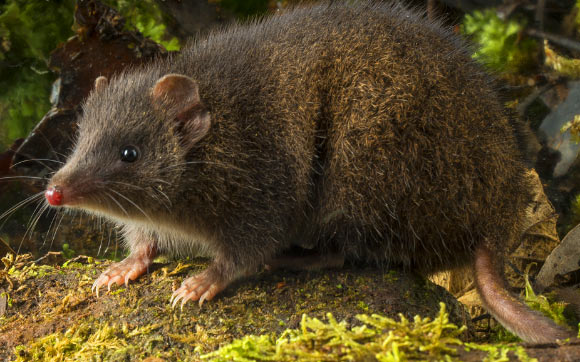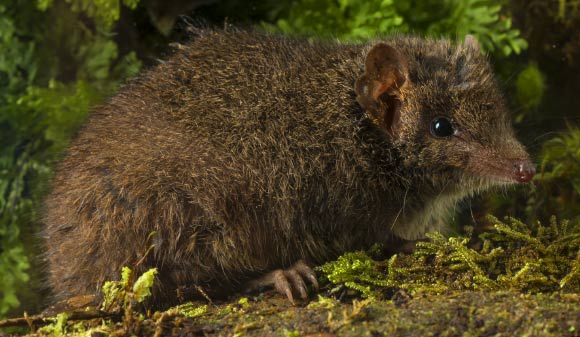A team of scientists led by Dr Andrew Baker from Queensland University of Technology has described two new species of carnivorous marsupials from Australia.

The Tasman Peninsula Dusky Antechinus (Antechinus vandycki). Image credit: Gary Cranitch / Queensland Museum.
One of the two new species, the Tasman Peninsula Dusky Antechinus (Antechinus vandycki), was discovered in remote, south-eastern Tasmania.
Its scientific name, vandycki, is in honor of Dr Steve Van Dyck, former Senior Curator of Mammals and Birds at the Queensland Museum, for his pioneering taxonomic work on the genus Antechinus.
It is a large antechinus, with a head-body length of 13 cm and a body mass of 90 g. The tail is shorter than the head and body.
“We discovered the Tasman Peninsula Dusky Antechinus not far from the old European settlement town of Port Arthur in Tasmania,” Dr Baker said. “Most of its limited habitat falls within state forest, which is being logged. This species now apparently only lives in tiny, fragmented stands of intact forest that are under threat.”
Another, previously known form, the Mainland Dusky Antechinus (Antechinus mimetes), was raised to species status. It is found in south-eastern Australia (New South Wales and Victoria).
“Uncovering new mammals in developed countries like Australia is pretty rare and the fact we’ve found even more antechinus species hints at the biodiversity jewels still waiting to be unearthed. It’s a shame that mere moments after discovery, these little Tasmanian marsupials are threatened with extinction at human hands,” said Dr Baker, who is the lead author on the paper in the journal Memoirs of the Queensland Museum – Nature.

The Mainland Dusky Antechinus (Antechinus mimetes). Image credit: Gary Cranitch / Queensland Museum.
He said the annual suicidal sexcapades of antechinus make them more vulnerable to population extinctions. Every year, all antechinus males fight ferociously for sex – then die.
“The breeding period is basically two to three weeks of speed-mating, with testosterone-fuelled males coupling with as many females as possible, for up to 14 hours at a time.”
“Ultimately, the testosterone triggers a malfunction in the stress hormone shut-off switch; the resulting rise in stress hormones causes the males’ immune systems to collapse and they all drop dead before the females give birth to a single baby,” Dr Baker said.
“This yearly male suicide mission, which halves each antechinus population, means the mums have enough spiders and insects to eat while they raise the next precious generation. But the future of each species is entrusted to the mothers alone.”
Dr Baker and his colleagues from Queensland University of Technology plan to seek extra funding to conduct further crucial research on these iconic yet mysterious mammals, including mapping their true geographical range, identifying measures that could help protect them and searching for as-yet undiscovered antechinus species.
_____
Baker A.M. et al. 2015. A taxonomic assessment of the Australian Dusky Antechinus Complex: a new species, the Tasman Peninsula Dusky Antechinus (Antechinus vandycki sp. nov.) and an elevation to species of the Mainland Dusky Antechinus (Antechinus swainsonii mimetes (Thomas)). Memoirs of the Queensland Museum – Nature, vol. 59, p. 75-126; doi: 10.17082/j.2204-1478.59.2015.2014-10







